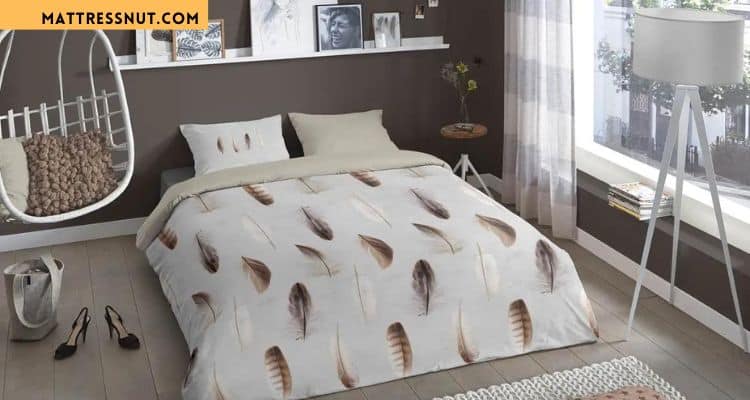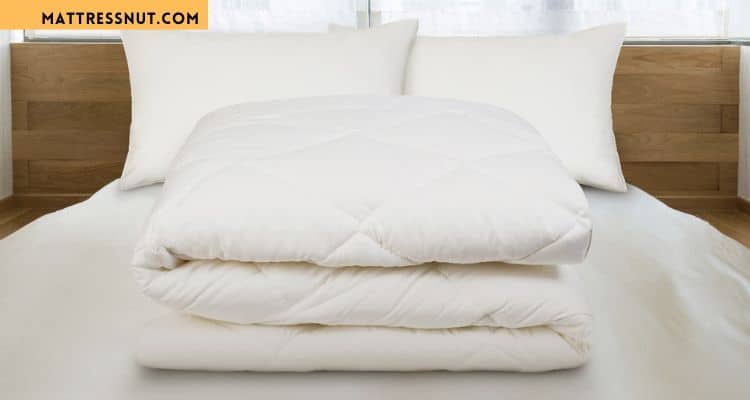Have you ever wondered what goes inside a duvet cover? You can make your bed look stylish and cozy using a duvet cover.
With their popularity, you can find various types of duvet covers on the market. Some are made of soft cotton, while others have luxurious satin or silky materials. Duvet covers come with colorful patterns to suit your taste.
By covering the duvet, you can instantly transform the appearance of your bed. So, why not explore the different options and find the perfect duvet cover for your bedroom?
But the question is, what goes inside a duvet cover? We’re about to learn all about it, so keep reading until the end.
What a Duvet Cover is Filled with?
A duvet cover is a soft and fluffy decorative and protective covering. It’s like a big pillowcase for your duvet, allowing you to change your bed’s look easily. But what exactly goes inside that cover?

The main component of a duvet is the duvet insert. It is usually filled with feathers, down, or a synthetic material like polyester. This filling provides warmth and comfort while you sleep. The duvet insert is placed inside the cover, keeping it clean and protected.
Duvet covers come in various materials and styles, allowing you to personalize your bedding. They are in soft cotton, luxurious satin, or cozy flannel. They come in different patterns and colors to match your bedroom decor.
How to Fill a Duvet Cover?
Filling a duvet cover is a straightforward process that can be done in a few simple steps. Here’s how you can fill a duvet cover:
- Lay the cover flat on your bed or a clean surface with the opening facing you.
- Spread the insert evenly over the cover, ensuring the corners align properly.
- Starting from the top, roll the duvet and cover together towards the opening, similar to rolling a sleeping bag. Continue rolling until you reach the end.
- Once rolled, reach inside the duvet cover opening and grab the rolled duvet.
- Unroll the duvet towards the foot of the bed, allowing it to settle inside the cover.
- Shake the duvet and cover gently to ensure the insert is evenly distributed.
- Finally, close the duvet cover using the buttons, snaps, or zipper provided.
Voila! Your duvet is now filled and ready to keep you warm and cozy. Remember, if your duvet cover has ties or loops, you can secure them to prevent the insert from shifting inside the cover. Enjoy a restful night’s sleep with your perfectly filled duvet cover.
Types of Fillings for Duvet Covers
Duvet covers come in various fillings, each offering unique characteristics and benefits. Here are some common types of fillings for duvet covers:
Down:
Down fillings are made from the soft clusters found beneath the feathers of ducks or geese. They provide exceptional warmth and insulation while remaining lightweight and breathable.
Feather:
Feather fillings are composed of the outer feathers of ducks or geese. They offer good insulation and a slightly heavier feel compared to down.
Synthetic:
Synthetic fillings, such as polyester or microfiber, are popular alternatives to natural fillings. They are hypoallergenic, affordable, and often mimic the warmth and softness of down.
Wool:
Wool fillings are naturally temperature-regulating, keeping you warm in colder months and cool during warmer seasons. They are hypoallergenic and moisture-wicking.
Silk:
Silk fillings provide luxurious comfort and a lightweight feel. They are known for their breathability and ability to regulate body temperature.
When choosing a duvet cover, consider your preferences, allergies, and climate to select the best filling. Whether you prefer the warmth of down, the affordability of synthetic options, or the natural benefits of wool or silk, there’s a filling type available to enhance your sleeping experience.
Choosing the Right Duvet Insert for Your Cover
The perfect duvet insert for your cover is crucial for a comfortable sleep experience. Consider factors such as warmth, weight, and allergies.
Down and feather inserts provide excellent insulation, while synthetic options like polyester offer affordability and hypoallergenic properties. Explore different fillings, and match them to your preferences and needs to ensure a cozy and restful night’s sleep.
Synthetic Fillings:
Synthetic fillings for duvet covers offer several advantages. They are often hypoallergenic, making them suitable for allergy sufferers. They are more affordable than natural fillings like down or feathers.
Plus, synthetic materials are easier to clean and maintain. However, they may not provide the same warmth and breathability as natural fillings. It’s essential to consider your specific needs and preferences when choosing a synthetic filling for your duvet cover.
Natural Fillings:
Regarding natural fillings for duvet covers, feather and down are popular choices. Feather fillings offer good insulation and a slightly heavier feel, while down provides exceptional warmth and lightweight comfort.

They are both breathable and cozy. However, it’s important to note that some individuals may have allergies or sensitivities to these natural materials. If so, alternative options may be more suitable for you.
Alternative Fillings:
For those seeking alternatives to natural fillings, microfiber fillings are popular. Microfiber offers softness and lightweight warmth and is hypoallergenic, making it suitable for allergy sufferers.
Other hypoallergenic options like polyester or bamboo-based fillings are also available. These alternatives often mimic the qualities of down or feathers, providing comfort and insulation without triggering allergies. Consider these options if you prefer a non-natural filling for your duvet cover.
Thread Count & Fabric Choices for Duvet Covers
Considering thread count and fabric choices for your duvet covers is essential for bedding comfort. Thread count refers to the number of threads woven into each square inch of fabric.
Higher thread counts generally indicate a softer and more durable fabric. Popular fabric choices for duvet covers include cotton, which is breathable and easy to care for, and luxurious options like satin or silk that provide a smooth and lustrous feel.
Moreover, flannel is a cozy option for colder climates. By selecting the right thread count and fabric, you can enhance your duvet cover’s overall comfort and aesthetic appeal.
Conclusion:
Understanding what goes inside a duvet cover is essential for creating a comfortable and stylish bed. You can achieve the desired level of warmth and insulation by selecting the right duvet insert, such as down, feather, or synthetic options.
Considerations for different seasons lead to choosing lighter or heavier fillings accordingly. Additionally, hypoallergenic fillings cater to allergy sufferers, while eco-friendly options provide sustainable bedding choices.
Thread count and fabric choices significantly enhance duvet covers’ overall comfort and aesthetic appeal. Whether you prefer the softness of cotton, the luxury of satin, or the cozy warmth of flannel, the right duvet cover can transform your bedroom into a haven of rest and relaxation.
What Goes Inside a Duvet Cover? FAQs
Do You Have to Put Something Inside a Duvet Cover?
Yes, a duvet cover is designed to cover a duvet insert or a comforter. It provides protection and allows for easy cleaning and changing of the bedding.
Does a Comforter Go Inside a Duvet?
Yes, a comforter can go inside a duvet cover. The duvet cover acts as a protective and decorative layer for the comforter, allowing you to change your bedding style easily.
What Types of Fillings Are Suitable for Different Seasons?
Lighter fillings like down alternatives or lighter-weight down can be suitable for warmer seasons. Heavier fillings like down, or feather can provide extra warmth and insulation in colder seasons.
Are There Eco-Friendly Options Available for Duvet Fillings?
Yes, there are eco-friendly options available for duvet fillings. Some examples include organic cotton, bamboo-based fibers, or recycled polyester fillings, which offer sustainable alternatives to traditional materials. These options contribute to a more environmentally friendly choice for your bedding.

